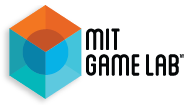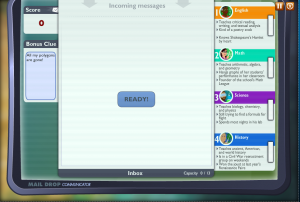Commercial Games for Academic Literacy
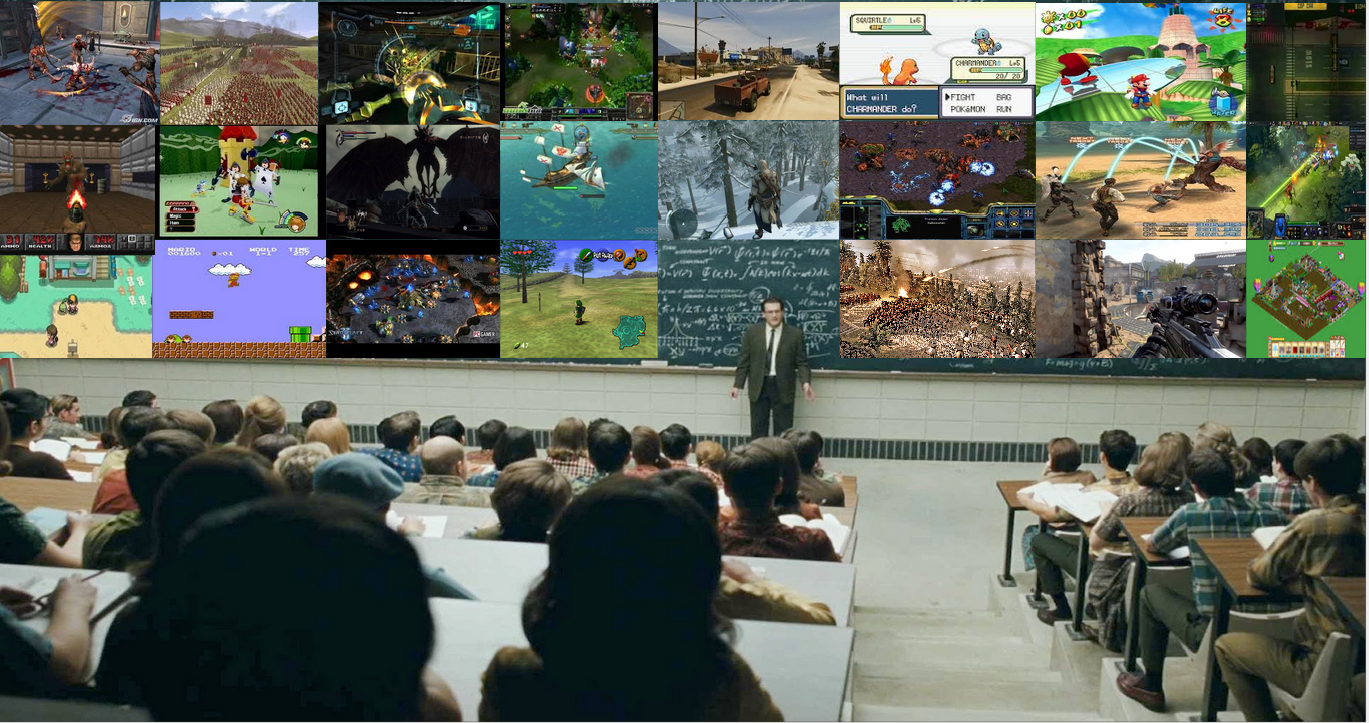
It’s no secret that video games have a long history with education. Some of the oldest educational video games have been around for decades. While we spend a lot of time and effort developing educational games, we should be discussing the potential of commercial games to foster academic literacy and successful learning strategies. I am positing a new way of looking at games for education. This involves stepping away from the classic dichotomy of ‘serious’ learning games versus commercial games and instead looking at how games affect their players and what we can glean simply from playing. Games, both digital and non-digital, open up a space for people to explore, strategize, and learn. They offer new perspectives on old subjects and allow players to break into difficult subjects with ease.
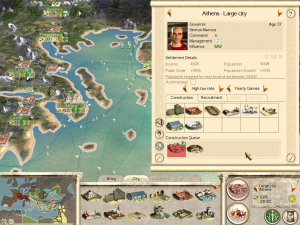 In the past when people have discussed the use of commercial games for learning, they usually take the standpoint of exhibiting a few gleaming examples of educational content within the perceived barren wasteland of commercial video games. Games like Sid Meier’s Pirates, Civilization, or the Total War series are often held aloft as these gems of education within the commercial game scene. I love these games as much as the next person, but we need to stop looking at games for the content they teach us and instead look at how the games teach us to learn. We need to focus on what games teach us when we aren’t asking to be taught.
In the past when people have discussed the use of commercial games for learning, they usually take the standpoint of exhibiting a few gleaming examples of educational content within the perceived barren wasteland of commercial video games. Games like Sid Meier’s Pirates, Civilization, or the Total War series are often held aloft as these gems of education within the commercial game scene. I love these games as much as the next person, but we need to stop looking at games for the content they teach us and instead look at how the games teach us to learn. We need to focus on what games teach us when we aren’t asking to be taught.
When assessing the academic use of video games, we tend to focus on two aspects of a game: content and gameplay mechanics. Either the game can teach students about a subject through walls of text, graphs, maps, and historical information, or it illustrates its usefulness through asking players to perform tasks like multiplication or balancing a chemical equation before the timer runs out. This isn’t the way we should be looking at the potential in games. Let’s look instead at how we can walk away from a game better equipped to be an active participant in education. I’d like to give you all an example of what I argue is the ideal format for learning in video games.
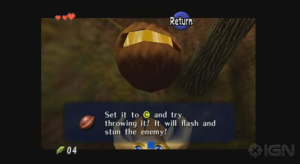 This is the story of the Deku Nut. This is a screenshot from Nintendo’s Legend of Zelda Ocarina of time from 1998. About 15 minutes into the game, the player acquires the item shown on the screen here, the deku nut. The tool tip at the bottom of the screen is the only instruction given to the player on the use of this new tool. “Try throwing it! It will flash and stun the enemy.” You get an opportunity to test out the deku nut a few seconds later as you’re confronted with another enemy. The tooltip is never shown again, and you don’t receive any other prompting to use the deku nut, it’s yours to use as you see fit.
This is the story of the Deku Nut. This is a screenshot from Nintendo’s Legend of Zelda Ocarina of time from 1998. About 15 minutes into the game, the player acquires the item shown on the screen here, the deku nut. The tool tip at the bottom of the screen is the only instruction given to the player on the use of this new tool. “Try throwing it! It will flash and stun the enemy.” You get an opportunity to test out the deku nut a few seconds later as you’re confronted with another enemy. The tooltip is never shown again, and you don’t receive any other prompting to use the deku nut, it’s yours to use as you see fit.
About an hour later into the game (2 if you were 8 years old like I was) you reach the first boss. Your companion on this journey lets you know that the creature has a giant, vulnerable eye. It stands to reason (even for an 8 year old) that your flashy deku nuts might help against an enemy with a giant, vulnerable eye. At this point in the game, you have many other tools at your disposal and there are many ways to beat this boss, but the most efficient involves using a tool you got at the very beginning of the game. This episode is not the true success of the game design in the Legend of Zelda though
After acquiring well over 20 new, and more powerful tools than the deku nut, you finally face the final boss of the game. It turns out that the deku nut you got back at the very beginning of the game damages this boss just as much as swinging your sword. The example of the deku nut in The Legend of Zelda exhibits exactly what good educational game design should look like. The player is given a toolkit and a strategy and it’s up to them to apply those strategies effectively in new situations. The game is teaching its players academic literacy and how to learn efficiently.
So what is academic literacy? In it’s simplest form, it is learning how to learn. It is the accumulation of the generic, transferable skills that are both required by and typically developed in academic settings. The tools for academic literacy are not necessarily developed in one school subject or another, but are rather developed through all of them. Academic literacy is a form of metacognition or knowing about knowing as Metcalfe and Shimamura discuss in their book on the subject. It is a skillset that allows a person to adapt and implement learned strategies in new situations for both problem solving and learning. The people we refer to as ‘good’ students are those who exemplify academic literacy. Academic literacy involves understanding both the problem they are confronted with as well as the relevant tools required to solve the problem efficiently.
Here lies one of the major problems we face in education today. Traditionally, we’ve held onto the idea that there are both good and bad students. We’ve written some students off as just being naturally better learners almost as if learning is a skill you’re either born with or you’re not. Carol Dweck talks about this in her book on Mindsets. We have this notion that people are fixed in their ways and just have to work with what they’ve been given. Instead, Dweck argues, we need to adopt a growth mindset. People’s qualities and strengths are not static things, they can be developed over time. Success can be taught. Learning can be taught. Academic literacy is not a skill you’re born with, it is a tool that can be taught and developed. It’s a tool that games are perfectly equipped to develop.
My work at the Education Arcade involves developing games that bolster academic literacy. The games pictured here are not educational for their content, but rather the skills that they require from players. They hone in on specific skills rather than content or mechanics. The game on the right, Mail Drop, is a game specifically made to develop scanning skills. The players are not prompted with an instructional tutorial that teaches them how to scan text quickly to pull out useful information, instead it presents a situation in which developing a scanning strategy is the pathway to success. Games are particularly adept at making players develop new skill sets.
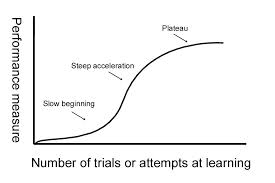 Every game we play comes with a learning curve. We have periods of slow learning, typically the first few minutes of a game where you learn the control scheme or the rules, but soon after this slow beginning period, we hit a huge spike in learning. We’ve mastered the basics of the gameplay, now we get to adopt new strategies, explore new techniques and combine gameplay elements into successful endeavors. Eventually, once we’ve mastered the game’s mechanics as well as the strategies that we can employ, we become highly proficient in the game, we’ve mastered it and our learning plateaus. Some games are notorious for having ridiculously steep learning curves. Games like Starcraft or League of Legends involve a huge investment of effort just to get past the slow beginning phase. Regardless of the steepness of a learning curve, the more of them we face, the more prepared we are for the next one. Learning a new subject is often frustrating, but the more you are faced with the slow beginning phase of a learning curve, the better equipped you are to deal with the next one. As we play, we develop skills which help us quickly delve into new subjects. This reasoning applies to both video games and school subjects. The more learning we do, the better we learn.
Every game we play comes with a learning curve. We have periods of slow learning, typically the first few minutes of a game where you learn the control scheme or the rules, but soon after this slow beginning period, we hit a huge spike in learning. We’ve mastered the basics of the gameplay, now we get to adopt new strategies, explore new techniques and combine gameplay elements into successful endeavors. Eventually, once we’ve mastered the game’s mechanics as well as the strategies that we can employ, we become highly proficient in the game, we’ve mastered it and our learning plateaus. Some games are notorious for having ridiculously steep learning curves. Games like Starcraft or League of Legends involve a huge investment of effort just to get past the slow beginning phase. Regardless of the steepness of a learning curve, the more of them we face, the more prepared we are for the next one. Learning a new subject is often frustrating, but the more you are faced with the slow beginning phase of a learning curve, the better equipped you are to deal with the next one. As we play, we develop skills which help us quickly delve into new subjects. This reasoning applies to both video games and school subjects. The more learning we do, the better we learn.
As gamers play, they learn and develop strategies applicable to learning in general. A recent study at Duke found that gamers actually view the world differently. The test involved a series of flashing letters on a screen. Players of action-games consistently out-performed non-gamers when asked to name which letters were on the screen. The study concluded that gamers are able to make probabilistic conclusions with much less information than non-gamers. This skill is something that is absolutely crucial to problem-solving according to Sanjoy Mahajan’s work on educated guessing and opportunistic problem-solving. The twitch reflexes of action video games require players to efficiently and strategically scan a visual scene for valuable information. These tools apply directly to academic literacy. The more we play, the more we develop these strategies.

Now, this is not to say that we should change the classroom to look something like this picture. I am specifically focusing on learning in non-traditional settings. The games I’ve been mentioning are those typically reserved for free time at home. We often underestimate the potential these games have to teach us skills that are applicable outside of the gaming world. The more we’re exposed to games and the strategies necessary to become competent in them, the more prepared we are to tackle things like chemistry, algebra, physics, and even history.
References
2014. Appelbaum, L.G. Schroeder, J.E., Darling, E.F., & Mitroff, S.R. Stroboscopic Visual Training Improves Information Encoding in Short-Term Memory.
2006. Dweck, Carol. Mindset.
1994. Geisler, Cheryl. Academic Literacy and the Nature of Expertise
1996. Metcalf, Janet and Shimamura, Arthur. Metacognition: Knowing about Knowing.
